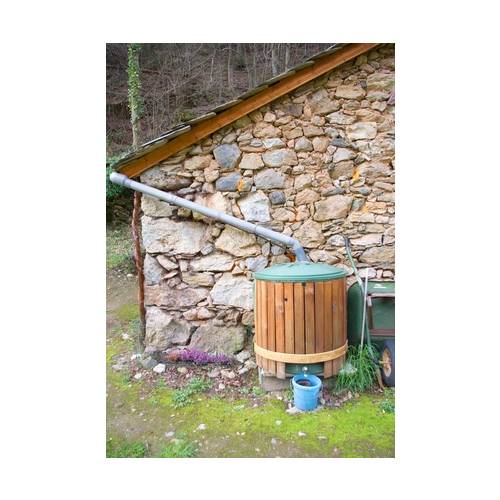
The art of watering
Recovering rainwater
- Details
-
Depending on the region where your garden is, you can realistically expect to recover between 400 and 800 litres of water per year for every m² of roof: this represents significant savings on your water bill !
The figures given by the manufacturers are often higher but do not trust them: they are calculated based of a flat roof that receives every drop of rain, which in reality is not the case. Despite this, it is still worth recovering rainwater.
Collector
You will find many commercialised systems that you connect to your gutters, on the down pipe to be exact. These sophisticated models include a filter to prevent leaves entering and only allow clean water to be collected. If you collect water directly from the drainpipe, it would contain a degree of impurities, which could dirty your water reserve. The risk is not so much that the water is dirty but rather that the impurities could block a sprinkler or other watering device! It is perfectly fine to water with water that is not crystal clear. Even rusty coloured water can be used on tougher plants (conifers, bamboos...). However, it is not ideal !
Storage
The problem arises from having to collect water at times when the garden’s needs are low, namely from the autumn through to the spring and then having to use it for watering your plants when there is a shortage. It is therefore important to envisage a tank that is going to be large enough so that this problem can be solved.
In areas where the summers tend to be dry, envisage a large tank (of about 10m3 ). This type of tank is usually sunk in to the ground and requires excavation work using a digger. It is a serious investment which will take several years to recover.
In wetter regions, a smaller tank of about (1m3) will suffice to bridge the gap between rains. Use a tank that is specially designed for recovering rainwater and resist the urge to use a container that may have contained dangerous substances. It is not only...silly but also potentially dangerous for you and the environment.
Also, make sure that the tank chosen allows you to see how much water it contains rather than you guessing: a water level indicator is a worthwhile option.
Usage
It is very easy to concentrate on how big a tank needs to be for storing the rainwater but we often overlook how accessible the water will be. Once the water is in the tank, we need to be able to get it out so we can water the plants. Without some sort of pump or pressurised system, you will soon be fed up of watering with a watering can, even if it does have its advantages !
A pump is a necessity. There exist complete kits that not only supply a pump but also a pressurised water supply, as if it was coming out of a tap. You can use this water for irrigation systems (sprinklers, drip pipes, etc) that require a certain level of pressure to work.
A healthy water tank
Ideally, the water tank should be purged each year before the autumn. The rainwater will always contain debris (bits of leaves, twigs, insects, etc) and the accumulation of sludge at the bottom of the tank is inevitable. This will be particularly true if there are trees near to the roof or if there is moss on the roof. In cold areas, tanks that are not buried could freeze totally in a very cold winter: empty them to avoid them splitting when frozen. - Photos (1)

